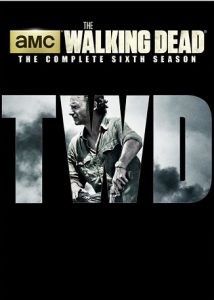Sunday’s episode of “The Walking Dead” featured cinematographically beautiful scenes of Morgan and his mentor, Eastman, practicing the martial art of aikido, along with powerfully acted moments of Morgan begging Eastman to kill him. But the most memorable part of the episode is Eastman’s monologues, which — taken together — tell the story of how he learned to value all life.
Usually, the rule of storytelling is “show, don’t tell.” But there are exceptions, such as Robert Shaw’s USS Indianapolis speech in “Jaws” … and now John Carroll Lynch’s stories in the 90-minute “Here’s Not Here.” Eastman, a prison psychologist before the apocalypse, was skilled at reading people’s true natures. So while an inmate named Crighton Dallas Wilton used his charm to fool officials into giving him perks such as time on a roadside work crew, Eastman saw Wilton was truly evil and denied him parole. Wilton escaped and killed Eastman’s wife, son and daughter. Then Eastman picked up Wilton – the only truly evil person among the 825 prisoners he interviewed in his career — from the prison road crew, put him in a cage in his cabin and watched him starve to death over the course of 44 days.
With that, Eastman had “come to value all life.”
Subtextually, “Here’s Not Here” – which plays like a two-lead indie film more so than a traditional TV episode – is a fascinating commentary on the nature of violence in humans. We tend to look at the problems of the world and assume people are inherently violent. Even if we personally wouldn’t commit violent crimes or join the military and fight overseas, we think we might be capable of doing what the otherwise peaceful Eastman did to Wilton. As guest Paul Bettany said on a recent “Talking Dead,” when a parent lays eyes on their child for the first time, they immediately realize they are capable of homicide should anyone hurt their child.
Eastman makes a good point, though: If humans were inherently violent, there wouldn’t have been scores of American soldiers coming back from the Middle East with PTSD before the zombie apocalypse. Humans do not have claws or armored shells. What soldiers are asked to do is not natural.
Furthermore, “Here’s Not Here,” through Eastman’s harrowing story, examines the difference between violence by proxy and close-up violence. We rarely note the difference between the two, but it’s incredibly significant. Indeed, humans’ ability to rationalize violence through the wrongful assumption that we are inherently violent comes about largely because most of the violence in the world is done by proxy.
For example, the U.S. government has killed hundreds of innocent people as part of its Middle East drone program. But what individual is responsible for those deaths? The commander in chief? The remote operator who presses the button? The military person who calls for the strike? The American taxpayers who successfully shamed the administration away from Syria in 2012 before giving up three years later? I’ve heard various arguments that no one is directly responsible. And yet the innocent people are still dead, and still more will die.

Through Eastman’s story, “The Walking Dead” makes a strong case that if an individual had killed the first of those innocent folks in Pakistan or Yemen or Afghanistan with his bare hands, rather than by using middlemen, perhaps the hundreds of additional deaths wouldn’t have followed.
My Middle East drone bombing example deals with innocent people. But Eastman actually learns to value all life by watching a demonstrably evil person die by his hand, suggesting that such an epiphany does not depend on the deceased being a good person – it’s the act of taking a life, period, that is drives home the lesson.
A written page from Eastman’s pamphlet on aikido (an even more extreme breaking of the “show, don’t tell” rule) explains that while many philosophies claim that all life is sacred, they are quick to make exceptions to the rule. This particular martial art – centered on a series of defensive and redirective forms with a long staff – practices what it preaches. (Subconsciously, I wonder if Donatello’s use of a bo staff – rather than the more inherently violent weapons of his brothers – is part of why he’s my favorite Ninja Turtle.)
But as much as I might want to hold up “Here’s Not Here” as evidence that pacifism (or even violence strictly for the sake of defense) isn’t as simplistic as is commonly assumed, “The Walking Dead” will quite possibly undercut this notion as Season 6 goes forward. As we learned at episode’s end, Morgan has an unwilling disciple of his own tied up in his Alexandria house: a member of the Wolves, a cult that believes it is now the natural state of things to kill and take, rather than to shake hands and barter. This Wolf promises to kill Morgan when he gets free – just as Morgan once promised the same to Eastman – and the look in his eyes suggests he’s one of those rare Crighton types who actually is evil, and will make good on his promise.
Does that undercut aikido, though? Not necessarily, as we come back to the wider theme that has emerged in recent seasons of “The Walking Dead”: What’s more important – surviving at any cost, or having something worth living for? Rick represents the former viewpoint, most starkly in the Season 5 finale when he guns down Pete (who had just killed someone with a sword) rather than secure him and go through a judicial process in Alexandria. He had killed many people before that, too. Morgan represents the latter viewpoint. So did Eastman, who was always more vulnerable to Morgan’s potential violence than even Morgan knew (the cage was unlocked, it turns out) – except that Eastman had looked into Morgan’s eyes and seen that he was not evil.
Rick is more likely to survive; in fact, he might be the last human left on the planet – surrounded by hordes of encroaching walkers — when “The Walking Dead’s” credits roll for the last time.
Morgan will probably bite it at the hands of his lone Wolf project before the season is over. However, he is more likely than Rick to live while he’s alive.

